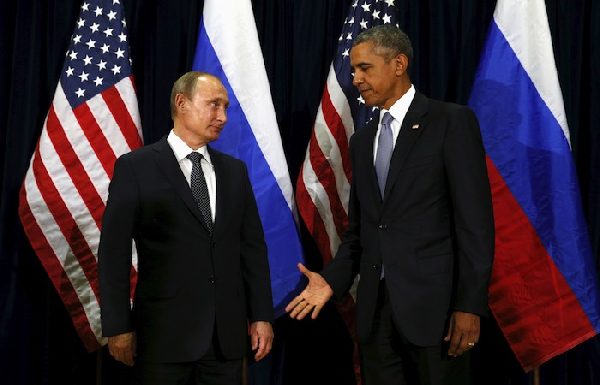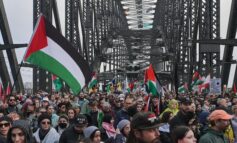
|
| President Obama extends his hand to Russian President Vladimir Putin during their meeting at the United Nations General Assembly in New York, Sept. 28, |
MOSCOW — Russia launched air strikes against targets in Syria on Wednesday in the Kremlin’s biggest intervention in the Middle East in decades, telling the U.S. air force to steer clear while its warplanes were in action.
Moscow’s assertion that it had attacked ISIS was immediately challenged by Washington and by rebel sources in Syria.
A U.S. official said Moscow gave Washington just an hour’s notice of the strikes, which the Kremlin said were designed to help President Bashar al-Assad, its closest regional ally, push back Islamist militants.
Notice of the attack came from a Russian official in Baghdad who asked the U.S. air force to avoid Syrian airspace during the mission, U.S. State Department spokesman John Kirby said.
Russia and the United States offered conflicting accounts of which targets had been struck, underlining growing tensions between the two former Cold War foes over Moscow’s decision to intervene.
U.S. officials said targets in the Homs area appeared to have been struck, but not areas held by ISIS.
Areas of the province of Homs struck by the Russians are controlled by an array of rebel groups including several operating under the banner of the “Free Syrian Army”, activists, locals and rebels said. None of the sources named ISIS as one of the groups operating in the areas hit on Wednesday.
The Russian Defense Ministry said however that its attacks were directed at ISIS military targets. It said it had hit ISIS weapons depots, ammunition, communications infrastructure, and fuel.
The head of the Western-backed Syrian political opposition said the Russian strikes had killed at least 36 civilians and targeted areas where ISIS and al Qaeda-linked fighters were not present.
According to a pro-Syrian government military source, there were “five strikes against five areas in Syria’s Homs.” He said other areas may have been bombed too.
The Homs area is crucial to Assad’s control of western Syria. Insurgent control of that area would bisect the Assad-held west, separating Damascus from the coastal cities of Latakia and Tartous, where Russia operates a naval facility.
Striking Homs and opposition groups but not ISIS showed the Kremlin’s primary aim was to prop up Assad, a French diplomatic source said.
Moscow’s intervention means the conflict in Syria has been transformed in a few months from a proxy war, in which outside powers were arming and training mostly Syrians to fight each other, to an international conflict in which the world’s main military powers except China are directly involved in fighting.
That raises the risks of military accidents between outside powers and raises pressure for a diplomatic solution, without making it any easier.
Russia joined the United States and its Arab allies, Turkey, France, Iran and Israel in direct intervention, with Britain expected to join soon, if it gets parliamentary approval.
-Reuters, TAAN






Leave a Reply